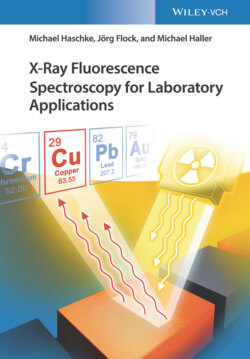Читать книгу X-Ray Fluorescence Spectroscopy for Laboratory Applications - Michael Haschke, Jörg Flock - Страница 46
3.5.1 Direct Measurement of Liquids
ОглавлениеFor the direct measurement, the liquids are filled into special sample cups (see Figure 3.17). The sample cups are available in several styles, each one designed to fit the different types of instruments; they can have different sizes and can be used with or without a cover. They are made of polymers (PE, Teflon), which inherently are very clean, in order to avoid introducing any foreign measurement signal.
Figure 3.17 Sample cup for the analysis of liquids.
Source: Courtesy of Chemplex Industries, Inc.
The cups are covered with polymer films, which must be pulled tightly onto the cup without any wrinkles; this is important in order to clearly define the distance between sample and spectrometer. On the one hand, the films should absorb the radiation as little as possible, i.e. they must be very thin and consist of elements with low atomic number. On the other hand, they must be stable against the liquids used. For the mostly organic solvents, this requires careful selection and testing before a measurement. It is therefore recommended to test the resistance of the window film of unknown samples, by filling the liquid into the sample cup and placing it on blotting paper for at least twice the measuring time. Thus, it can be verified whether the liquid reacts with the films or not. This is important in particular for wavelength-dispersive (WD) instruments; due to their high excitation intensity the thin films of the sample cup are thermally stressed. It is therefore essential to carry out these tests for WD spectrometers for a sufficiently long period.
This high excitation intensity of WDS instruments can also alter the sample, for example, by decomposition, which can then lead to generating bubbles in the liquid.
The samples should always be filled into the sample cups just before the measurement. For particularly aggressive solvents, it is also advisable to use a double film for covering the cup.
In the case of a defective foil, there is a high risk that the liquid enters the spectrometer, which then can lead to considerable damage, both by potential temperature shock to the X-ray tube and by contamination or reaction of the solvent with the spectrometer components.
Available window materials and their properties are summarized in Table 3.11. The transmission of low-energy radiation is shown in Figure 3.18 for different commonly used window materials. For light elements such as Na, Mg, or Al the transmission is fairly small, but for slightly higher energies, such as S, the transmission is already increased. However, this is not a real disadvantage because liquids cannot be measured in vacuum, which means the radiation is absorbed also in air. In any case, the absorption in the different layers always has to be considered during analysis.
Table 3.11 Window materials for sample cups for liquid samples.
| Material | Elements | Minimal thickness (μm) | Properties |
|---|---|---|---|
| Mylar (PET) | Hydrogen, carbon, oxygen | 2.5 | Very thin = > small absorptionLow to no contaminationsSuitable for: aqueous solutionsNot suitable for aliphatic alcohols, alkaline solutions, ester, aromatic hydrocarbons, and ketonesImpurities of the film can have the following concentrations: Phosphorus – approx. 180 μg/g; calcium – approx. 45 μg/g |
| Polypropylene (PE) | Hydrogen, carbon | 4 | Small absorption due to light elementsSuitable: all organic solventsNot suitable: aromatic and halogenated hydrocarbons, ketones, etherOften contaminations from silicon, sulfur, or calcium |
| Kapton | Hydrogen, carbon, nitrogen, oxygen | 6 | Stronger absorption due to heavier elementsHigh temperature resistance, high radiation resistance for continuous measurementSuitable: aqueous solutions |
Figure 3.18 Transmission of low-energy radiation of sample cup films.
For highly volatile solutions, sample cups with a cover are offered to reduce the evaporation process (see right cup in Figure 3.17).
The preparation steps for liquids are generally determined by their state. In the case of a homogeneous liquid, the preparation is simple – the liquid can readily be filled into the sample cup and measured.
On the other hand, a multiphase liquid, having different densities, for example, can be homogenized by stirring or shaking. The measurement should then be carried out shortly after the homogenization in order to avoid a new segregation. Another possibility is the separation of the individual phases and their separate analysis.
If particulate material is suspended in liquid, homogenization by shaking and stirring is also required, in an ultrasonic bath, for example. The measurement should also be done quickly, in order to avoid new sedimentation. Another possibility is to filter the suspended particles in order to analyze the filtered particles and the liquid separately.
